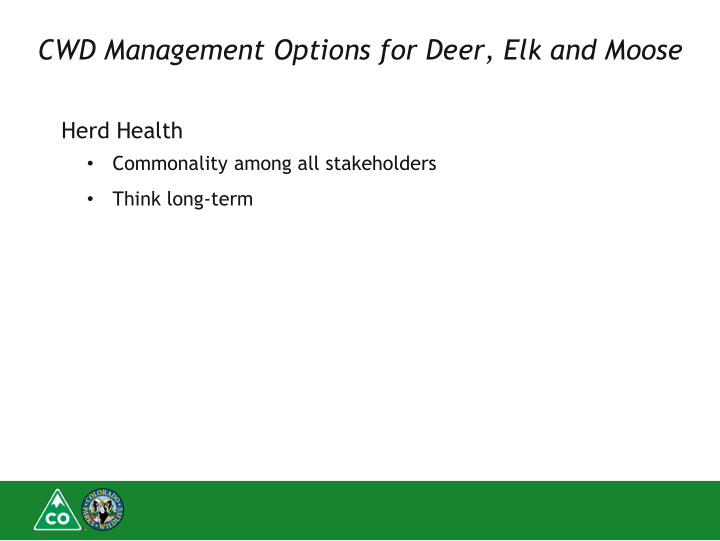



CWD Management Options for Deer, Elk and Moose Herd Health Commonality among all stakeholders • Think long-term •
CWD Management Options for Deer, Elk and Moose Herd Health Commonality among all stakeholders • Think long-term • Management Considerations Maximum effect on prevalence, minimum effect on the herd • Confidence in prevalence from mandatory testing • Scale • Before-After-Control-Impact, Concurrency of varied treatments • • Frequency of treatments, Adaptive Repeated mandatory testing every five years •
CWD Management Options for Deer, Elk and Moose 1. Reduce Artificial Points of Host Concentration Eliminate prion point sources • Reduce cervid densities at point sources • 2. Harvest Management Increase harvest • Shift timing of harvest to when older animals are more vulnerable • 3. Maximize Ability to Remove Diseased Animals 4. Herd Management Plans
CWD Management Options for Deer, Elk and Moose 1. Herd Management Plans Update objectives for outdated plans • Prioritize plan updates according age and level of prevalence • Manage population and composition to the set objectives • If high prevalence, possible first step to manage towards the lower end of the objective ranges set in the plan
CWD Management Options for Deer, Elk and Moose 2. Reduce Artificial Points of Host/ Prion Concentration Supplemental feeding, baiting, minerals, water sources, etc. • Cooperate with landowners and agriculture partners Wise disposal of cervid parts • Cooperate with taxidermists and meat processors High prevalence town/open space herds • Cooperate with municipalities
CWD Management Options for Deer, Elk and Moose 3. Harvest Management Increase harvest to remove infected individuals • Deer have highest prevalence compared to elk and moose • Deer Management Considerations • Statewide observed 2017 buck/doe ratio = 34/100 Statewide 2017 buck/doe ratio objective = 30/100 High prevalence herd, bucks have 2x infection rate Decrease buck/doe ratio (increase adult buck harvest) Local management, appropriate scale and action Above Population Objective (30% of deer herds) High prevalence herd, high densities Decrease population/density (Increase doe harvest)
Reduce Buck/Doe Ratio a) Increase male hunting licenses b) Increase male harvest in late seasons or in high prevalence areas c) Shift male harvest from early seasons to late seasons in high prevalence areas d) Adjust hunt codes to focus harvest e) Eliminate float groups to better control late season hunter pressure f) Increase opportunities for male harvest, such as changing male licenses from List A to List B, increasing availability of Private Land Only (PLO) licenses, and hunting on open spaces g) Increase male harvest by creating a Special Hunting Season for Disease Management in Big Game
Reduce Population/Density a) Increase female and either sex hunting licenses b) Increase harvest in late seasons or high prevalence areas c) Increase opportunities for harvest, such as increasing access or the availability of PLO licenses and hunting on open spaces d) Increase harvest by creating a Special Hunting Season for Disease Management in Big Game e) Increase harvest through targeted population reductions not related to hunter harvest. In areas where hunters are not able to access herds, CPW will consider the use of focused herd reduction measures as a last resort.
CWD Management Options for Deer, Elk and Moose 4. Maximize Ability to Remove Diseased Animals Identify and manage CWD hot spots • Tailor licenses to focus on hot spots •
Harvest Targeting Disease Foci Targeted harvest strategy built upon ongoing fall harvest to maximize removal of infected individuals. Example: Harvest surveys in D-19 & D-40 revealed that most CWD cases were concentrated in the Uncompahgre River valley (map). Using “disease management” licenses to target disease foci may be effective in suppressing CWD in this situation.
D-07 CWD+ SPATIAL DATA (2017)
Recommend
More recommend